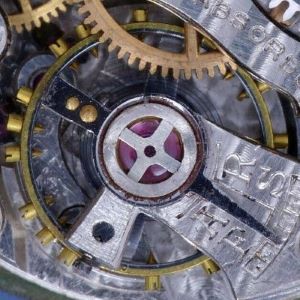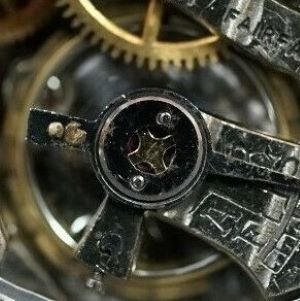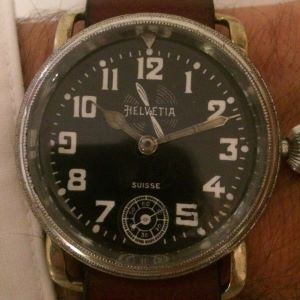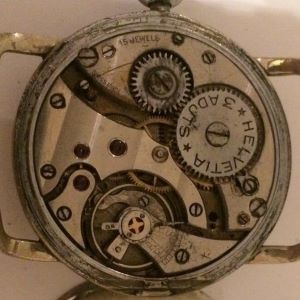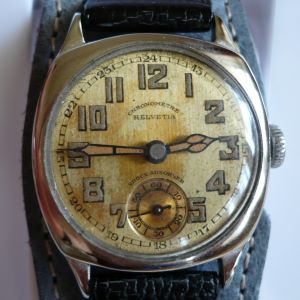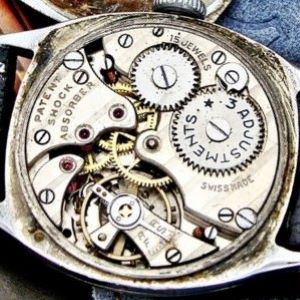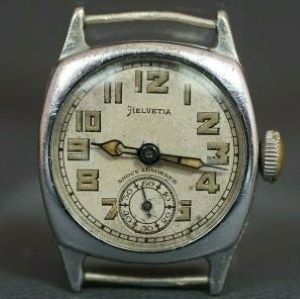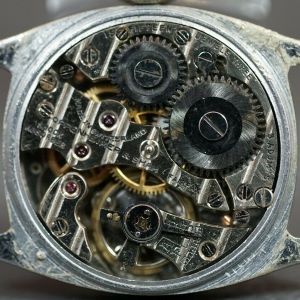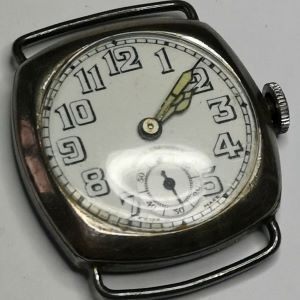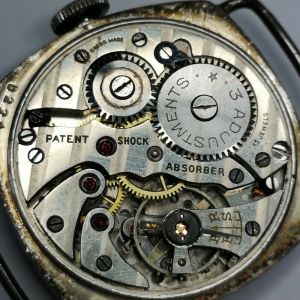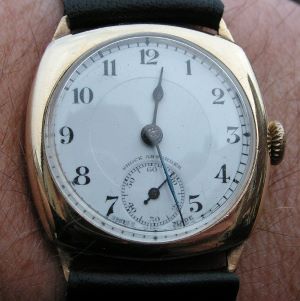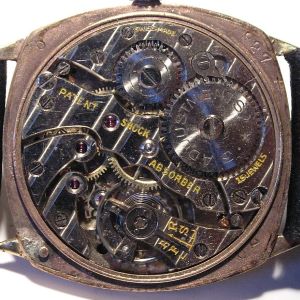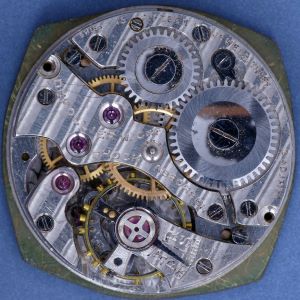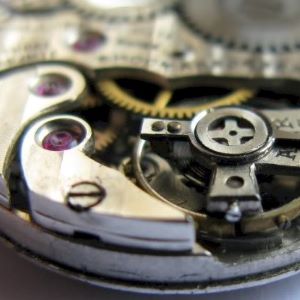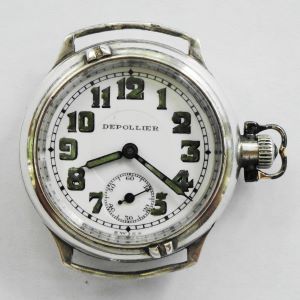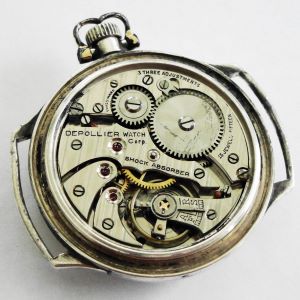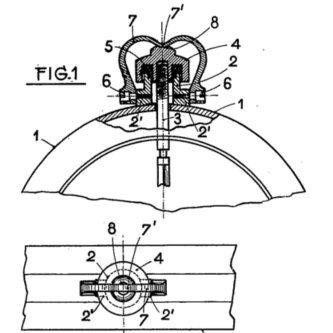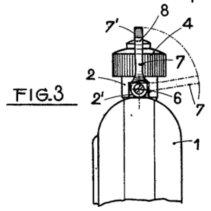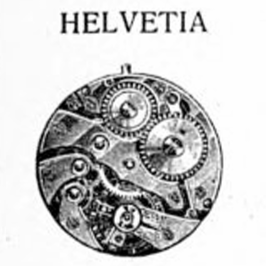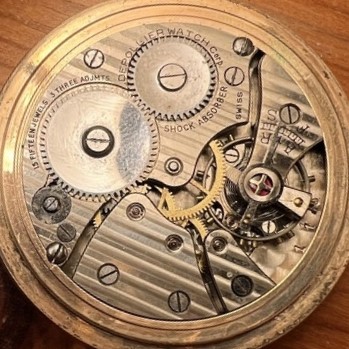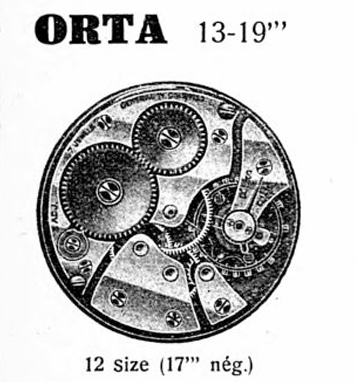Helvetia & The Depollier Watch Corp.
- Helvetia History
- Mar 30, 2019
- 8 min read
Updated: Dec 10, 2024
For a while I have been aware that Helvetia were using a 'cross' shaped shock protection system at about the time they patented their own system in 1930. By 1935 they had stopped using it and only produced watches with their own patent design. This was a bit of a mystery to me, I wasn't sure if it was an earlier version of their own system or something else.
Recently I came across several movements that I didn't immediately recognise using this cross shaped system, some with Helvetia dials others not marked Helvetia but with other signs that they were Helvetia watches. Early watches are not always marked with the manufacturers details so sometimes you need to use other clues such as other text on the dial or movement, serial numbers, case styles etc. Over the year I've had plenty of practice of spotting a hidden Helvetia watch from these signs.
I had a feeling some of these movements were not made by Helvetia even though they were in Helvetia watches, it is not unusual for manufacturers to use movements from a different supplier, though as Helvetia had their own movements they did not normally do this. In an effort to help identify these movements I asked for help on a forum and someone helpfully pointed out the similarity of the shock protection to Depollier watches using the Brun shock protection system.
Jacques Depollier & Son was an American watch manufacturer who specialised in waterproof and shock protected watches, including screw down waterproof crowns, during WW1 and the 1920s.
During the 1920s Depollier got into financial difficulties and the company was relaunched several times under different names until the Depollier Watch Corporation was formed in 1926. Due to problems obtaining parts from US suppliers after his money problems it is known that Depollier turned to Switzerland for the supply of movements but not much more than that. It does seem though that the Depollier Watch Corporation may have gone out of business by the early 1930s. After further research I have become convinced that Depollier was working with Helvetia during this time.
I hope to show below the relationship between the two companies working my way back from later clearer examples to earlier not so clear cut ones but hopefully if I can join the dots it will make sense!
So onto pictures of the watches, all those pictured below have the cross type shock protection I believe may be of the Depollier/Brun type.
First of all a simple one. This is a known Helvetia movement, 51S-10, marked Helvetia on the movement and dial in a Helvetia pilot's watch from the early 1930s.
Next an unknown movement. This watch has a Helvetia marked dial and a known Helvetia case with a Helvetia serial number 366xxxx, 1931 (General Watch Company/Helvetia serial numbers between 1925 and 1935 range from 34xxxxx to 38xxxxx. With other factors this is a good indicator of a Helvetia watch as there were not many other manufacturers with such high serial numbers at this time). Note the '3 Adjustments dot, star, dot' text on the barrel of the movement this is a distinctive sign of Helvetia movements and is seen on almost all of their movements from this period whether Helvetia marked on the dial or not.
Next is a Fabrique d'Horlogerie de Fontainemelon (FHF) movement in a watch with a Helvetia marked dial the same case as the above watch and Helvetia serial number 379xxxx, 1934. Helvetia manufactured their own movements so it is unusual to see another manufacturer's movement in one of their watches.
So far so good, all the above watches are signed Helvetia somewhere and have other signs of being made by Helvetia.
Now we have two watches that are not marked as Helvetia and have the same FHF movement with a particular bridge configuration that only seems to have been used with movements that have Depollier/Brun type shock protection fitted. This is a slightly larger version of the FHF movement above.
After laying the groundwork above with a bit of luck you can see the similarities to the Helvetia marked watches, for example the '3 Adjustments' text with the distinctive font, particularly the letter N. Both these watches also have Helvetia serial numbers, both 362xxxx, 1930. The bottom watch also has a dedication on the reverse dated 1931 which adds a little extra corroboration.
Hopefully we are now happy that all the watches above are Helvetia watches, whether marked or not but we could ask where does Depollier fit in here? These watches could all just be using a Helvetia shock protection system that looks a bit similar to the Depollier/Brun system.
There are not many pictures of Swiss Depollier marked movements but below are two pictures of Depollier marked Swiss movements with Depollier/Brun shock protection fitted. (Note the Depollier Watch Corp name).
You will notice, though it's a bit difficult in the second picture, that these two movements are exactly the same two FHF movements, with the same bridge configuration, as used in the Helvetia watches fitted with FHF movements above.
This is a start but the best indication that the shock protection as seen in the Helvetia watches above was a version of the Depollier shock protection and that Helvetia were also making watches for Depollier, and what this whole post has been leading up to, lies in the special watch pictured below.
This watch is the only known example of a Depollier 4th generation waterproof watch. (This was correct at the time of writing, I have since seen another 3 examples as of 2024). Depollier had made three previous versions of a watch with a waterproof case using US made movements during WW1 but after financial difficulties with US suppliers during the 1920s it was believed that Depollier turned to Switzerland for the next version of his watch. However no example was known to exist until this one was found by Stan Czubernat of LRF Antique Watches in 2017.
I think this watch too was made by Helvetia. The most obvious clue is the shock protection, it is of the particular type that I have only seen in watches I believe are made by Helvetia. It also supports the fact this shock protection used by Helvetia is of the Depollier/Brun type as it is hard to believe Depollier would have used any other shock protection than the one he owned the patent on in a watch made for him by someone else.
The movement is again by FHF. A larger variant, with the same bridge configuration, of the movement used in the two unmarked watches above.
The silver case carries Swiss hallmarks that I understand were in use between the mid 1920s and 1933. It also carries a serial number 348xxxx which would date the watch to 1927. This date appear correct as the watch is marked Depollier Watch Corp and we know that this company wasn't formed until 1926. This is more supporting evidence for the serial number being a Helvetia one.
During the 1930s Helvetia sold many waterproof and shockproof watches to retailers who rebranded them but they almost always carried a Helvetia serial number. G & M Lane of London with their Aero and Aeroplane watches, Abercrombie & Fitch with their Shipmate and Huber from Germany with their Nautica and Secura lines.
So the shock protection, movement and serial number all fit but what about other features of this watch, perhaps the rather odd looking crown?
Several years ago when I fist started properly researching Helvetia I came across the patent pictured below applied for by The General Watch Company, the parent company of Helvetia. I added an image of it to my page about Helvetia sports watches with the comment that I had never seen a watch with this type of waterproof crown.
Well I think I have now! It certainly looks to be the same crown as on the Depollier watch and the patent application date of 1927 is also interesting.
The patent is for:
CLAIM:
Wristwatch with winding, characterized in that the winding crown is mounted on a tube welded to the watch case by means of a compressible seal, the winding crown pressing on said lining, under the action of a clamp hinged to the tube and acting at the top of the crown.
SUB-CLAIM:
Winding according to the claim, characterized in that the winding crown has, at its apex, a concave part, in which is engaged and maintained an indented part of the clamp.
So nobody else but The General Watch Company/Helvetia could have been making watches with this sort of crown without infringing on the patent.
The last pieces of the jigsaw are the lugs on the Depollier waterproof watch. Again they are quite unusual but rang a bell with me. Then I remembered where I'd seen something like them before. This watch is an odd but fantastic looking Helvetia watch from, according to the movement and serial number, about 1945. Very different from the normal cases around at this time but very similar to the lugs on the Depollier from nearly 20 years earlier.
Perhaps with supply issues at the end of the war Helvetia were using up old stock or just thought, as I do, it looked good! If it wasn't for the style of numerals on the dial, the movement (notice the later Helvetia shock protection) and the serial number the watch could be from the 1920s!
Given everything above I am convinced that Helvetia had a relationship with the Depollier Watch Corporation and made the only known 4th generation Depollier waterproof watch. It looks like they then went on to use Depollier/Brun shock protection in their watches into the 1930s before replacing it with their own patented shock protection system.
I would be interested to hear anyone else's view. Please leave a comment below, you don't need to log in.
UPDATE:
I have recently come across the watch below which strengthens the links laid out above. Note it has the same movement as the two unnamed watches that I believe to be Helvetia but this time it is marked as Helvetia on the dial. It is also almost identical, just a slightly smaller version, to the movement in the Depollier waterproof watch. I think either the General Watch Co/Helvetia made all these watches or Depollier made them for Helvetia and as they are Swiss watches with what appear to be Helvetia serial numbers I think the first option is the most likely.
UPDATE 2:
I have recently been sent a copy of a Helvetia advert from 1949, part of which is replicated below. So we now have the General Watch Co claiming this movement as their own and being used in their Helvetia waterproof watches by 1929. I think there can be no doubt with all the evidence above that the Depollier watch was also made by the General/Helvetia.

UPDATE 3:
Over the past couple of years I have found more watches and some adverts that I think prove that Helvetia/General Watch Co were making watches for Depollier in the 1920s. I'll just add a couple below.
Here is a Depollier Watch Corp marked watch, with the Depollier/Brun shock protection using a Helvetia movement the same as the one in the diagram above.
And another Depollier Watch Corp marked watch, with the slightly later Depollier/Brun shock protection, this time using a General Watch Co Orta pocket watch movement.
And lastly a version of the Depollier waterproof watch above with dial and movement markings and serial number all completely in alignment with Helvetia watches of this period and with the same Helvetia movement.
Basically this is the Helvetia version of the watch they made for Depollier.
The serial number on this watch is 1500 earlier than the Depollier marked one. I have also since seen two other examples of this watch. Another Depollier marked one and a rolled gold watch branded 'The Fenchurch Lever' which was a brand name used by the General Watch Co in Australia.


